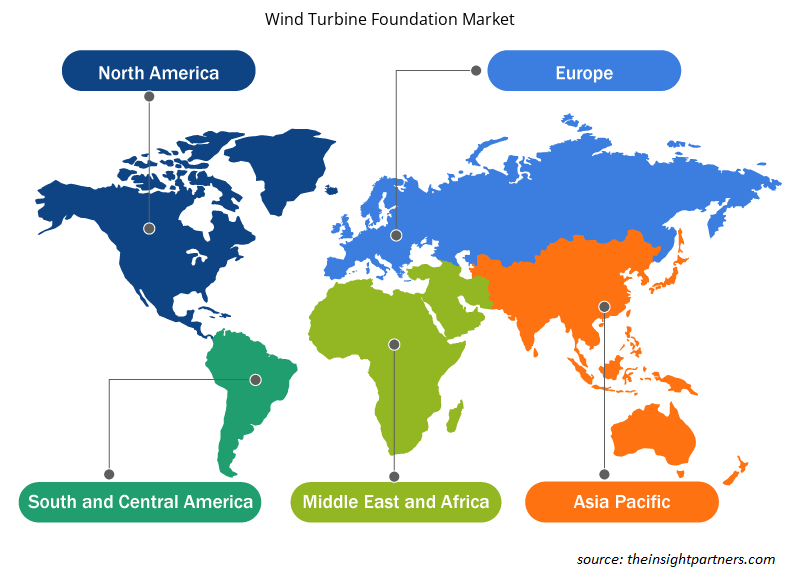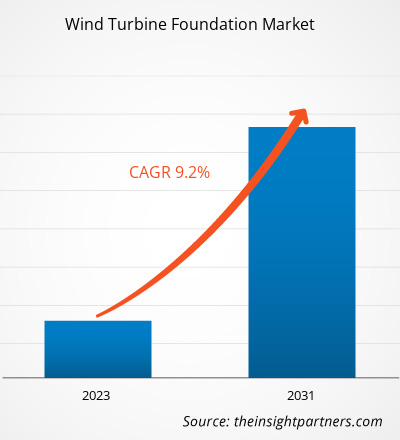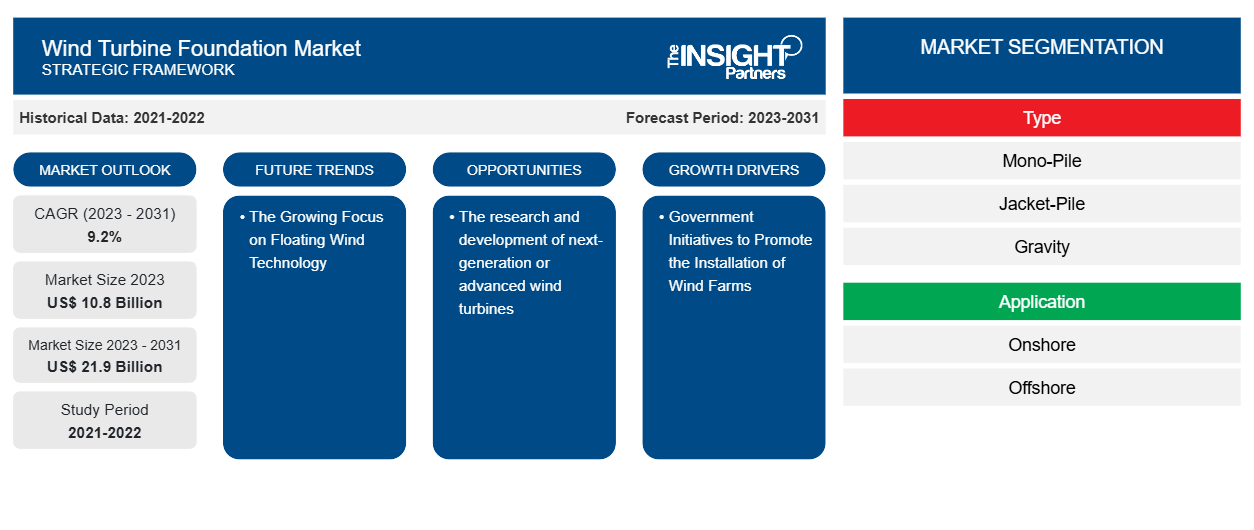Das Marktvolumen für Fundamente für Windkraftanlagen soll von 10,8 Milliarden US-Dollar im Jahr 2023 auf 21,9 Milliarden US-Dollar im Jahr 2031 anwachsen. Für den Zeitraum 2023–2031 wird ein durchschnittliches jährliches Wachstum von 9,2 % erwartet. Die Forschung und Entwicklung von Windkraftanlagen der nächsten Generation oder von fortschrittlicheren Windkraftanlagen dürften weiterhin wichtige Trends auf dem Markt bleiben.
Marktanalyse für Windturbinenfundamente
Der Markt für Windkraftanlagenfundamente dürfte im analysierten Zeitraum aufgrund der zunehmenden Zahl von Onshore- und Offshore-Windkraftprojekten, insbesondere an abgelegenen Standorten, ein erhebliches Wachstum verzeichnen. Darüber hinaus dürften die staatlichen Vorschriften zur Reduzierung der CO2-Emissionen durch die Konzentration auf die Stromerzeugung durch erneuerbare Energiequellen wie Wind, Sonne, Geothermie und andere das Marktwachstum von 2023 bis 2031 vorantreiben. Darüber hinaus dürften staatliche Initiativen zur Errichtung von Windparks auf der ganzen Welt das Marktwachstum in den kommenden Jahren ankurbeln.
Marktübersicht für Windturbinenfundamente
Mit der wachsenden Bevölkerung und Industrialisierung steigt auch der Energiebedarf auf globaler Ebene. Der Anstieg des Energieverbrauchs steigerte auch den Bedarf an erneuerbarer Energieerzeugung in Entwicklungs- und Industrieländern. Dies hat zu einer steigenden Nachfrage nach Windkraftinfrastruktur auf der ganzen Welt geführt. Die Windkrafterzeugung hat im Vergleich zu anderen erneuerbaren Energiequellen weltweit an Bedeutung und Akzeptanz gewonnen. Fortschrittliche technologische Entwicklungen bei der Konstruktion und Entwicklung von Rotorblättern, Turbinen, Fundamenten, Schächten und anderen Komponenten haben zu erheblichen Fortschritten bei der Nutzung der Windenergie und zur Erzielung maximaler Leistung aus dem verfügbaren Wind beigetragen. Laut der Internationalen Agentur für Erneuerbare Energien (IRENA) erreichte die weltweit installierte Windkapazität bis Ende 2023 1.017 GW (von 825 GW im Jahr 2021).
Daher wird erwartet, dass sich die installierte Windkapazität in den kommenden Jahren aufgrund der Vorteile der Windenergie sowie günstiger Richtlinien, Anreize und Steuererleichterungen weiter erhöhen wird. Ein solcher Anstieg der installierten Windkapazität weltweit wird voraussichtlich der Haupttreiber auf dem Markt für Windturbinenfundamente sein.
Passen Sie diesen Bericht Ihren Anforderungen an
Sie erhalten kostenlose Anpassungen an jedem Bericht, einschließlich Teilen dieses Berichts oder einer Analyse auf Länderebene, eines Excel-Datenpakets sowie tolle Angebote und Rabatte für Start-ups und Universitäten.
-
Holen Sie sich die wichtigsten Markttrends aus diesem Bericht.Dieses KOSTENLOSE Beispiel umfasst eine Datenanalyse von Markttrends bis hin zu Schätzungen und Prognosen.
Treiber und Chancen auf dem Markt für Windturbinenfundamente
Regierungsinitiativen zur Förderung der Installation von Windparks zur Begünstigung des Marktes
Eine verstärkte Unterstützung durch verschiedene Regierungen verschiedener Länder in Form von Richtlinien, Subventionen und Investitionen zur Steigerung der Installation von Windenergieprojekten wird voraussichtlich das Wachstum des Marktes für Windturbinenfundamente im analysierten Zeitraum ankurbeln. Die indische Regierung ist bestrebt, Windkraftanlagen im Land durch private Finanzierung zu fördern, indem sie verschiedene steuerliche und finanzielle Anreize wie beschleunigte Abschreibungsvorteile und ermäßigte Zölle oder Steuerbefreiungen für bestimmte Komponenten von Windkraftgeneratoren bietet . So plant Deutschland beispielsweise, einen Gesetzentwurf zur Beschleunigung des Ausbaus der Windenergie einzuführen. Das neue Gesetz wird verbindliche Flächenziele für den Ausbau der Windenergie an Land in den Bundesländern festlegen. Im April 2022 plante Deutschland, mithilfe eines historischen Pakets namens Osterpaket, das die tiefgreifendste Reihe von Änderungen in der deutschen Energiepolitik darstellt, ab 2025 Offshore-Windziele auf über 10 GW pro Jahr auszudehnen. Mithilfe dieser Regierungsinitiativen werden bis 2030 80 % des deutschen Strombedarfs durch Strom aus erneuerbaren Energiequellen gedeckt.
Der wachsende Fokus auf schwimmende Windtechnologie
Bei der schwimmenden Windtechnologie handelt es sich um eine Offshore-Windturbine, die auf einer schwimmenden Struktur im Meer montiert ist, die sicherstellt, dass die Turbine in Wassertiefen Strom erzeugt. Die schwimmende oder Offshore-Windtechnologie ist unter rauen Umweltbedingungen hocheffizient und kann daher enorme Mengen Strom erzeugen. Diese schwimmende Windtechnologie wird weltweit in verschiedenen Ländern wie China, Deutschland, Japan, Großbritannien, Frankreich, Belgien und Dänemark eingesetzt. Die Wachstumsaussichten bei der Einführung der schwimmenden Windtechnologie sind in erster Linie auf einen zunehmenden technologischen Fortschritt, die damit verbundenen Vorteile und die schlüsselfertigen Lösungen verschiedener Dienstleister zurückzuführen. Das wachsende Bewusstsein für die Erreichung sauberer Energieziele in verschiedenen Ländern treibt die Nachfrage nach schwimmender Offshore-Windkraft an, was eine potenzielle Chance für das Wachstum des Marktes für Windturbinenfundamente darstellt.
Der Bericht des Floating Offshore Wind Centre of Excellence hat 22 Länder identifiziert, die am ehesten dazu bereit sind, wichtige Akteure in der aufkommenden Technologie für erneuerbare Energien zu werden. Im Januar 2022 kündigte die britische Regierung 11 Projekte für erneuerbare Energien an, die jeweils mit bis zu 959,23 Millionen US-Dollar gefördert werden. Damit stellt sie 2,97 Milliarden US-Dollar bereit, um die in Großbritannien erzeugte erneuerbare Energie zu steigern. Solche Investitionen in Offshore- oder schwimmende Windtechnologie auf der ganzen Welt werden voraussichtlich das Marktwachstum in den kommenden Jahren ankurbeln.
Marktbericht zu Fundamenten für Windkraftanlagen – Segmentierungsanalyse
Schlüsselsegmente, die zur Ableitung der Marktanalyse für Windturbinenfundamente beigetragen haben, sind Typ und Anwendung.
- Je nach Typ ist der Markt für Windkraftanlagenfundamente in Monopile, Jacket-Pfahl, Schwerkraft, Dreibein, Saug-, Floß-, Pfahl-, Brunnen-, Fels- und Ankerfundamente und andere unterteilt. Das Schwerkraftsegment hatte 2023 einen größeren Marktanteil.
- Basierend auf der Anwendung ist der Markt in Onshore und Offshore segmentiert. Das Onshore-Segment hatte im Jahr 2023 einen größeren Marktanteil.
Marktanteilsanalyse für Windturbinenfundamente nach geografischer Lage
Der geografische Umfang des Marktberichts für Windkraftanlagenfundamente ist hauptsächlich in fünf Regionen unterteilt: Nordamerika, Asien-Pazifik, Europa, Naher Osten und Afrika sowie Süd- und Mittelamerika.
Der asiatisch-pazifische Raum dominierte 2023 den Markt für Windturbinenfundamente. Die Region Asien-Pazifik umfasst China, Australien, Indien, Südkorea, Japan und den Rest des asiatisch-pazifischen Raums. Der asiatisch-pazifische Raum hatte 2023 den größten Marktanteil am globalen Markt für Windturbinenfundamente und wird im Prognosezeitraum voraussichtlich mit der höchsten CAGR wachsen. Die robuste Onshore-Industrie und die Präsenz einer großen Anzahl von Herstellern von Windturbinenfundamenten in der gesamten Region sind für den hohen Marktanteil verantwortlich. Darüber hinaus kurbelt der wachsende Offshore-Sektor in China, Japan, Südkorea und Südostasien den Markt für Anbieter von Windturbinenfundamenten in der gesamten Region an. Darüber hinaus wird erwartet, dass ein Anstieg der Investitionen in die Installation von Onshore- und Offshore-Windparks in der Region die Nachfrage nach Windturbinenfundamenten in den kommenden Jahren ankurbeln wird.
Regionale Einblicke in den Markt für Windturbinenfundamente
Die regionalen Trends und Faktoren, die den Markt für Windturbinenfundamente im Prognosezeitraum beeinflussen, wurden von den Analysten von Insight Partners ausführlich erläutert. In diesem Abschnitt werden auch die Marktsegmente und die Geografie von Windturbinenfundamenten in Nordamerika, Europa, im asiatisch-pazifischen Raum, im Nahen Osten und Afrika sowie in Süd- und Mittelamerika erörtert.

- Erhalten Sie regionale Daten zum Markt für Windturbinenfundamente
Umfang des Marktberichts über Fundamente für Windkraftanlagen
| Berichtsattribut | Details |
|---|---|
| Marktgröße im Jahr 2023 | 10,8 Milliarden US-Dollar |
| Marktgröße bis 2031 | 21,9 Milliarden US-Dollar |
| Globale CAGR (2023 - 2031) | 9,2 % |
| Historische Daten | 2021-2022 |
| Prognosezeitraum | 2023–2031 |
| Abgedeckte Segmente |
Nach Typ
|
| Abgedeckte Regionen und Länder |
Nordamerika
|
| Marktführer und wichtige Unternehmensprofile |
|
Marktteilnehmerdichte für Fundamente für Windkraftanlagen: Auswirkungen auf die Geschäftsdynamik verstehen
Der Markt für Fundamente für Windkraftanlagen wächst rasant. Dies wird durch die steigende Nachfrage der Endnutzer aufgrund von Faktoren wie sich entwickelnden Verbraucherpräferenzen, technologischen Fortschritten und einem größeren Bewusstsein für die Vorteile des Produkts vorangetrieben. Mit der steigenden Nachfrage erweitern Unternehmen ihr Angebot, entwickeln Innovationen, um die Bedürfnisse der Verbraucher zu erfüllen, und nutzen neue Trends, was das Marktwachstum weiter ankurbelt.
Die Marktteilnehmerdichte bezieht sich auf die Verteilung der Firmen oder Unternehmen, die in einem bestimmten Markt oder einer bestimmten Branche tätig sind. Sie gibt an, wie viele Wettbewerber (Marktteilnehmer) in einem bestimmten Marktraum im Verhältnis zu seiner Größe oder seinem gesamten Marktwert präsent sind.
Die wichtigsten auf dem Markt für Windkraftanlagenfundamente tätigen Unternehmen sind:
- Fugro
- Ramboll Group A/S
- Iberdrola SA
- BW Ideol
- Peikko-Gruppe
- EEW-Gruppe
Haftungsausschluss : Die oben aufgeführten Unternehmen sind nicht in einer bestimmten Reihenfolge aufgeführt.

- Überblick über die wichtigsten Akteure auf dem Markt für Windturbinenfundamente
Neuigkeiten und aktuelle Entwicklungen zum Markt für Windturbinenfundamente
Der Markt für Windkraftanlagenfundamente wird durch die Erhebung qualitativer und quantitativer Daten nach Primär- und Sekundärforschung bewertet, die wichtige Unternehmensveröffentlichungen, Verbandsdaten und Datenbanken umfasst. Nachfolgend sind einige der Entwicklungen auf dem Markt für Windkraftanlagenfundamente aufgeführt:
- Odfjell Oceanwind kooperierte mit Prodtex. Ziel dieser Zusammenarbeit war es, die Produktionskapazität für schwimmende Windkraftanlagen zu steigern. Ziel ist es, die Anlage bis 2027 in Betrieb zu nehmen. (Quelle: Odfjell Oceanwind, Pressemitteilung, Februar 2024)
- Principle Power hat ein neues schwimmendes Windkraftfundament auf Pontonbasis mit dem Namen WindFloat F auf den Markt gebracht. Dieses Fundament ist für die Integration ultraflacher Windkraftanlagen in Häfen konzipiert (Quelle: Principle Power, Pressemitteilung, September 2023)
Marktbericht zu Fundamenten für Windkraftanlagen – Umfang und Ergebnisse
Der Bericht „Marktgröße und Prognose für Windkraftanlagenfundamente (2021–2031)“ bietet eine detaillierte Analyse des Marktes, die die folgenden Bereiche abdeckt:
- Marktgröße und Prognose für Windturbinenfundamente auf globaler, regionaler und Länderebene für alle wichtigen Marktsegmente, die im Rahmen des Projekts abgedeckt sind
- Markttrends und Marktdynamiken für Fundamente für Windkraftanlagen wie Treiber, Einschränkungen und wichtige Chancen
- Detaillierte PEST- und SWOT-Analyse
- Marktanalyse für Windturbinenfundamente mit Blick auf wichtige Markttrends, globale und regionale Rahmenbedingungen, wichtige Akteure, Vorschriften und aktuelle Marktentwicklungen
- Branchenlandschaft und Wettbewerbsanalyse, die die Marktkonzentration, Heatmap-Analyse, prominente Akteure und aktuelle Entwicklungen auf dem Markt für Windturbinenfundamente umfasst
- Detaillierte Firmenprofile
- Historische Analyse (2 Jahre), Basisjahr, Prognose (7 Jahre) mit CAGR
- PEST- und SWOT-Analyse
- Marktgröße Wert/Volumen – Global, Regional, Land
- Branchen- und Wettbewerbslandschaft
- Excel-Datensatz
Aktuelle Berichte
Verwandte Berichte
Erfahrungsberichte
Grund zum Kauf
- Fundierte Entscheidungsfindung
- Marktdynamik verstehen
- Wettbewerbsanalyse
- Kundeneinblicke
- Marktprognosen
- Risikominimierung
- Strategische Planung
- Investitionsbegründung
- Identifizierung neuer Märkte
- Verbesserung von Marketingstrategien
- Steigerung der Betriebseffizienz
- Anpassung an regulatorische Trends























 Kostenlose Probe anfordern für - Markt für Windturbinenfundamente
Kostenlose Probe anfordern für - Markt für Windturbinenfundamente